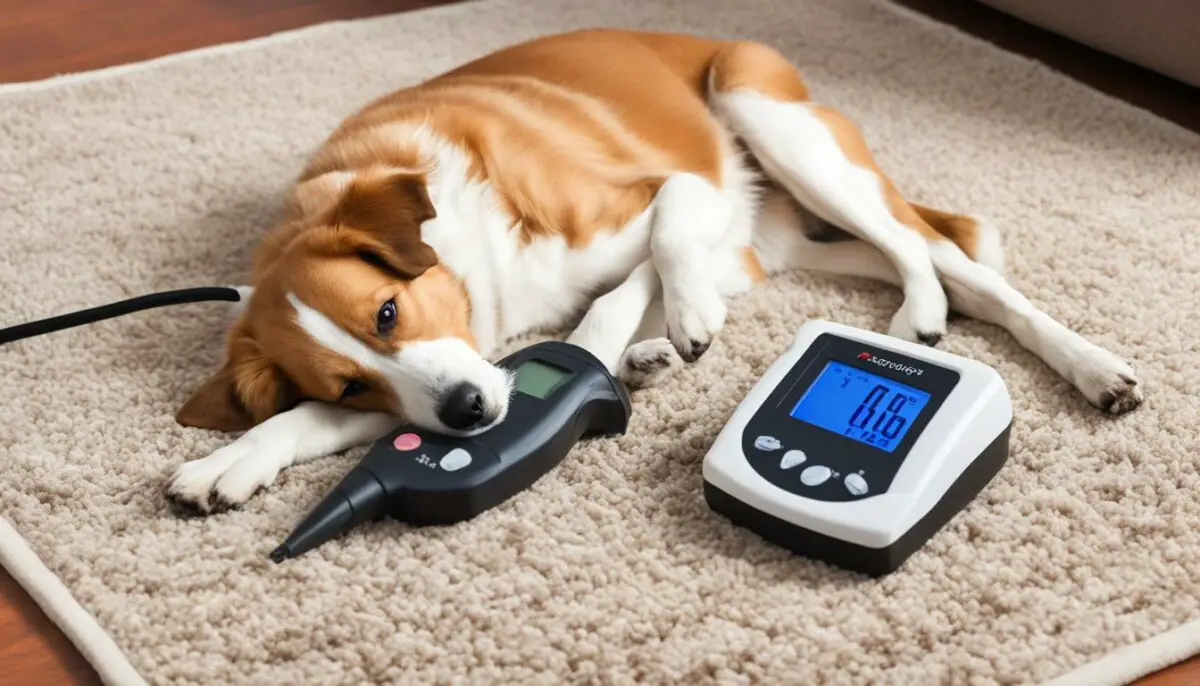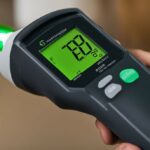Last Updated on 4 months by Francis
Knowing how to accurately measure a dog’s body temperature is essential for their health. While there are different methods available, using an infrared thermometer on dogs requires special consideration to ensure safety and accuracy. In this article, we will explore the guidelines and factors to consider when using an infrared thermometer on dogs, as well as alternative methods for measuring their temperature.
Contents
Key Takeaways:
- Using an infrared thermometer on dogs can be challenging due to potential inaccuracies and limitations.
- The most reliable methods for measuring a dog’s temperature include rectal thermometers and ear thermometers.
- Normal temperature range for dogs is between 99 and 102.5 degrees Fahrenheit.
- Regular temperature checks are generally unnecessary for healthy dogs, but it’s important to monitor their temperature during recovery from illness or in specific situations.
- If a dog’s body temperature falls outside the normal range or they exhibit signs of illness, it’s important to seek veterinary advice.
Normal Temperature Range for Dogs

Understanding the normal temperature range for dogs is essential for ensuring their well-being and monitoring their health. While a healthy dog’s body temperature typically falls between 99 and 102.5 degrees Fahrenheit, it’s important to recognize that there can be variations in temperature based on various factors.
Dogs’ body temperatures can be influenced by the environmental conditions they are in, such as the ambient temperature and humidity. Additionally, a dog’s excitement or anxiety levels can also affect their body temperature. It’s worth noting that infection, inflammation, and overexertion can raise a dog’s body temperature, while pregnant dogs or those with underlying health issues may have lower temperatures.
To accurately measure a dog’s body temperature and identify any potential abnormalities, it is crucial to be aware of the dog’s normal temperature range. This knowledge serves as a baseline for comparison and helps identify deviations that may indicate health concerns.
Here’s a handy temperature range table for dogs:
| Temperature Range (Fahrenheit) | Status |
|---|---|
| Below 99 | Below Normal |
| 99 – 102.5 | Normal |
| Above 102.5 | High |
Note: The table above serves as a general guideline for a healthy dog’s body temperature. Always consult with a veterinarian for specific guidance tailored to your dog’s individual needs.
Accurately monitoring a dog’s body temperature is crucial for prompt detection of potential health issues and ensuring timely intervention. By recognizing the normal temperature range for dogs and regularly checking their temperature, pet owners can stay vigilant when it comes to their furry friends’ well-being.
Importance of Taking a Dog’s Temperature

Taking a dog’s temperature is an essential aspect of responsible pet care, especially in certain situations. Monitoring a dog’s temperature can provide valuable insights into their overall health and well-being. Here are two key reasons why taking a dog’s temperature is important:
Predicting the Onset of Labor in Pregnant Dogs
For owners of pregnant dogs, monitoring their temperature can help predict the imminent arrival of their puppies. A significant drop in temperature, usually below the dog’s normal range, may indicate that labor is imminent within the next 24 hours. This information allows owners to prepare for the birthing process and provide appropriate assistance if needed.
Tracking Recovery from Illness or Infection
Monitoring a dog’s temperature can be instrumental in determining the progress of their recovery from a serious illness or infection. A persistently high temperature or sudden rise in temperature may indicate an ongoing infection or potential complications. Conversely, a consistent return to the normal temperature range can often be a positive sign of improvement. Regular temperature checks can guide owners and veterinarians in adjusting treatments and ensuring the dog’s recovery is on track.
By regularly monitoring a dog’s temperature in specific situations, pet owners can take proactive measures to ensure their well-being and provide timely medical attention when necessary.
| Situation | Reason for Temperature Monitoring |
|---|---|
| Pregnant Dogs | Predicting labor onset |
| Recovery from Illness or Infection | Tracking progress and detecting complications |
Different Methods to Take a Dog’s Temperature
When it comes to taking a dog’s temperature, there are several methods available, each with its own considerations. While some approaches are safer and more accurate than others, it’s crucial to choose the method that best suits your dog’s needs. Let’s explore the different methods:
- Rectal Thermometer: The rectal thermometer is the most reliable method for measuring a dog’s temperature. To use a rectal thermometer, follow these steps:
- Ensure the rectal thermometer is clean and lubricated.
- Gently lift your dog’s tail and insert the thermometer into the rectum.
- Hold the thermometer in place until you hear a beep or until the reading stabilizes.
- Remove the thermometer and clean it thoroughly.
This method may require an extra pair of hands to keep your dog calm during the process.
To make an informed decision about which method to use, consult with your veterinarian to ensure the safety and well-being of your furry friend.
| Method | Description | Accuracy | Recommended |
|---|---|---|---|
| Rectal Thermometer | Safe and reliable method involving insertion of a thermometer into the rectum. | High | Yes |
| Ear Thermometer | Non-invasive method that measures temperature from the ear canal. | Moderate | Yes |
| Infrared Thermometer | Uses infrared technology to measure temperature without direct contact. | Varies | No |
Frequency of Temperature Checks
Regular temperature checks for healthy dogs are generally unnecessary. However, if a dog is recovering from an illness or infection and a veterinarian has instructed to monitor their temperature at home, checking two to three times a day is sufficient. It’s important to follow veterinary guidance regarding the frequency of temperature checks, as excessive monitoring can cause unnecessary stress for the dog.
Tips to Keep Dogs Calm during Temperature Taking

Some dogs may not tolerate rectal temperature measurements, which can lead to increased stress levels for both the dog and the person taking the temperature. To keep dogs calm during temperature taking, it’s helpful to maintain a calm demeanor and use a reassuring tone when speaking to them. Using treats or rewards can create a positive association with the process. If necessary, having a second person gently restrain the dog or providing a gentle touch throughout the process can help keep them calm and cooperative.
| Tip | Description |
|---|---|
| 1 | Maintain a calm demeanor |
| 2 | Use a reassuring tone |
| 3 | Use treats or rewards |
| 4 | Have a second person gently restrain if needed |
| 5 | Provide a gentle touch throughout the process |
When approaching dogs for temperature taking, it’s important to make them feel comfortable and secure. A calm demeanor and reassuring tone can help alleviate their anxiety. Using treats or rewards as positive reinforcement can create a pleasant association with the process, making the dog more cooperative. If a dog becomes anxious or resistant, having a second person gently restrain them can provide added support. Additionally, maintaining a gentle touch throughout the process can help reassure the dog and keep them calm.
Concerns about Abnormal Temperatures

If your dog’s body temperature falls outside the normal range of 99 to 102.5 degrees Fahrenheit, it is understandable to have concerns. While a slight fluctuation may not always be cause for immediate alarm, there are instances where it is important to seek veterinary advice.
If your dog’s temperature is more than a degree outside the normal range, it is recommended to consult with a veterinarian. They can provide guidance and assess whether further investigation or treatment is necessary for your dog’s well-being.
In addition to the temperature reading, you should also pay attention to your dog’s overall appearance and behavior. If your dog appears sick, weak, or exhibits other concerning symptoms in conjunction with an abnormal temperature, it is crucial to seek immediate veterinary attention. Trust your instincts as a pet owner and prioritize your dog’s health and well-being.
Abnormal temperatures can be indicative of underlying health issues or the need for medical intervention. Prompt action and professional advice can help identify potential problems early on and ensure your dog receives appropriate care.
To better understand the significance of abnormal temperatures in dogs, here’s a table summarizing the potential causes and recommended actions:
| Abnormal Temperature | Possible Causes | Recommended Actions |
|---|---|---|
| Temperature above 102.5°F | Heat stroke, infection, inflammation | Seek immediate veterinary attention. Provide a cool environment, fresh water, and encourage rest. If necessary, cool your dog using wet towels and a fan before transporting them to a veterinary clinic. |
| Temperature below 99°F | Hypothermia, underlying health conditions | Seek veterinary advice. Move your dog to a warmer environment, and gently warm them using blankets or towels. Avoid using heating pads, hot water bottles, heat lamps, or electric blankets. |
Remember, as a pet owner, you play a crucial role in monitoring your dog’s health. It is always better to err on the side of caution and seek veterinary advice when you have concerns.
Dealing with High Body Temperature in Dogs

If your dog’s body temperature is above 103.5 degrees Fahrenheit after being active outside, it’s important to take immediate action to prevent further complications. High body temperature in dogs can lead to heat exhaustion or even heat stroke, which can be life-threatening if not treated promptly.
Here are some steps you can take to help your dog cool down:
- Provide a cool environment: Bring your dog indoors or to a shaded area with good air circulation. Avoid direct sunlight or hot surfaces.
- Offer fresh water: Make sure your dog has access to clean, cool water. You can also add ice cubes to the water bowl to help lower their body temperature.
- Encourage rest: Allow your dog to rest and avoid any strenuous activities. Overexertion can worsen their condition.
Watch out for signs of heat exhaustion or heat stroke, including:
- Weakness or lethargy
- Panting excessively
- Difficulty breathing
- Vomiting or diarrhea
- Unsteady gait or collapse
It’s crucial to remember that heat stroke is a medical emergency. If your dog shows severe symptoms or struggles to recover, don’t hesitate to seek immediate veterinary care.
While transporting your dog to the vet, you can take measures to cool them down:
- Use wet towels: Wet a towel with cool (not cold) water and place it on your dog’s neck, groin area, and armpits. This can help to dissipate heat.
- Provide airflow: Use a fan or open car windows to increase airflow and help cool your dog.
Remember, if your dog exhibits a high body temperature and appears sick or has a fever without recent physical activity, it’s important to consult a veterinarian for proper diagnosis and treatment. Prompt veterinary care can make a significant difference in their recovery.
Dealing with Low Body Temperature in Dogs

If a dog’s body temperature is below 99 degrees Fahrenheit, it is important to seek veterinary advice. Low body temperature in dogs can be a sign of underlying health issues and requires prompt attention. To help warm a dog with low body temperature, follow these guidelines:
- Move the dog to a warmer environment: Find a comfortable and draft-free area in your home to help increase the dog’s body temperature.
- Use blankets and towels: Wrap the dog in warm blankets and towels to provide insulation and assist in raising their body temperature.
Important: Avoid using heating pads, hot water bottles, heat lamps, or electric blankets to warm the dog. These methods can pose a risk of burns and should be avoided to ensure the dog’s safety.
Gently warming the dog is essential to prevent any sudden temperature changes that could further disrupt their health. Gradually increasing their body temperature in a safe manner helps avoid additional stress or harm to the dog.
Using Human Thermometer on Dogs
When it comes to taking a dog’s temperature, digital human thermometers can be a useful tool. However, certain precautions need to be taken to ensure accurate measurements and prevent any accidental human use. Labeling the thermometer appropriately is crucial to distinguish it for veterinary purposes only.
Note: It’s important to consult with a veterinarian before attempting to take a dog’s temperature at home.
Using a human thermometer for rectal temperature measurement in dogs involves the following steps:
- Gather the necessary supplies: a digital human thermometer, petroleum jelly or water-based lubricant, and disposable gloves.
- Prepare the thermometer: Ensure that the thermometer is thoroughly cleaned and sanitized before use. It’s essential to follow the manufacturer’s instructions for proper usage.
- Protective gear: Put on disposable gloves to maintain hygiene.
- Positioning: Gently hold the dog’s tail to expose the rectal area.
- Lubrication: Apply a small amount of petroleum jelly or water-based lubricant to the thermometer’s tip to facilitate smooth insertion.
- Insertion: Carefully insert the thermometer into the dog’s rectum, ensuring that it goes in approximately one inch.
- Hold and wait: Keep the thermometer in place until it beeps or a sufficient period has passed for an accurate reading.
- Remove and record: Slowly remove the thermometer and note down the recorded temperature.
- Sanitize: Clean the thermometer thoroughly after use to prevent cross-contamination.
Remember, rectal temperature measurement with a human thermometer should only be performed when necessary and under veterinary guidance. It’s important to exercise caution and ensure the dog’s comfort and safety during the process.
Expert Tip: For a more accurate and reliable temperature measurement, it’s recommended to use veterinary-specific thermometers, such as rectal or ear thermometers designed specifically for dogs.
Pros and Cons of Using Human Thermometer on Dogs
| Pros | Cons |
|---|---|
| Convenient and readily available | Potential risk of accidental human use |
| Relatively cost-effective | May not provide the most accurate readings |
| Easy to use with proper labeling | Requires proper cleaning and sanitization |
| Might cause discomfort or stress for the dog |
While a human thermometer can serve as a temporary solution, it’s recommended to invest in a thermometer specifically designed for veterinary use. These thermometers are designed to provide more accurate and reliable readings, ensuring the well-being of our furry friends.
Conclusion
Measuring a dog’s temperature is a crucial part of their healthcare routine. While using an infrared thermometer on dogs may seem convenient, it’s important to be aware of its limitations and potential inaccuracies. For more reliable temperature measurement, rectal thermometers and ear thermometers are recommended options.
Following proper guidelines and seeking veterinary advice when necessary are essential to ensure the safety and well-being of dogs when using temperature measuring devices. Understanding the normal temperature range for dogs is vital for accurate temperature assessment, as it can vary based on various factors such as ambient temperature, humidity, and health status.
Regular temperature checks for healthy dogs are generally unnecessary, but monitoring a dog’s temperature is crucial during illness, recovery, or pregnancy. Abnormal temperatures can be indicative of underlying health issues, and immediate veterinary attention may be required.
By utilizing reliable and approved methods for temperature measurement and staying informed about the normal temperature range for dogs, pet owners can take proactive steps to monitor their canine companions’ health effectively.
FAQ
Can I use an infrared thermometer on my dog?
While using an infrared thermometer on dogs is possible, it requires special consideration for safety and accuracy. There are important guidelines and factors to consider before using an infrared thermometer on your dog.
What is the normal temperature range for dogs?
The normal temperature range for dogs is between 99 and 102.5 degrees Fahrenheit. However, a dog’s body temperature can vary based on various factors such as ambient temperature, humidity, excitement or anxiety levels, and health status.
Why is it important to take a dog’s temperature?
Taking a dog’s temperature is important in certain situations, such as monitoring their recovery from illness or infection. It can also be helpful in predicting the onset of labor in pregnant dogs. Understanding the importance of temperature measurement in specific situations can assist in providing appropriate care for your dog’s well-being.
What are the different methods to take a dog’s temperature?
The most reliable method to take a dog’s temperature is using a rectal thermometer, which involves gently inserting a lubricated thermometer into the dog’s rectum. An ear thermometer specifically designed for veterinary use is another option. While using an infrared thermometer on dogs is possible, its effectiveness for measuring body temperature is still under debate.
How often should I check my dog’s temperature?
Regular temperature checks for healthy dogs are generally unnecessary. However, if your dog is recovering from an illness or infection and a veterinarian has instructed you to monitor their temperature at home, checking two to three times a day is sufficient. It’s important to follow veterinary guidance regarding the frequency of temperature checks.
How can I keep my dog calm during temperature taking?
Some dogs may not tolerate rectal temperature measurements, which can lead to increased stress levels. To keep dogs calm during temperature taking, it’s helpful to maintain a calm demeanor and use a reassuring tone when speaking to them. Using treats or rewards can create a positive association with the process. If necessary, having a second person gently restrain the dog or providing a gentle touch throughout the process can help keep them calm and cooperative.
When should I seek veterinary advice regarding abnormal temperatures in my dog?
If your dog’s body temperature falls outside the normal range of 99 to 102.5 degrees Fahrenheit, it can be a cause for concern. It’s important to seek veterinary advice if the temperature is more than a degree outside the normal range or if your dog appears sick or weak along with an abnormal temperature.
What should I do if my dog has a high body temperature?
If your dog’s body temperature is above 103.5 degrees Fahrenheit after being active outside, it’s important to provide a cool environment, fresh water, and encourage rest. Signs of weakness, lethargy, or nausea may indicate heat exhaustion or heat stroke, which requires immediate veterinary care.
What should I do if my dog has a low body temperature?
If your dog’s body temperature is below 99 degrees Fahrenheit, seeking veterinary advice is recommended. Moving the dog to a warmer environment and using blankets and towels to warm them is advisable. However, it’s essential to avoid using heating pads, hot water bottles, heat lamps, or electric blankets, which can pose a risk of burns.
Can I use a human thermometer to measure my dog’s temperature?
Digital human thermometers can be used to take rectal temperatures in dogs. However, it’s essential to label the thermometer appropriately to prevent any accidental human use. While human thermometers can be effective, it’s important to ensure they are used solely for veterinary purposes.
What are the guidelines for using an infrared thermometer on dogs?
While using an infrared thermometer on dogs is possible, it’s important to consider the limitations and potential inaccuracies associated with this method. Rectal thermometers and ear thermometers are more reliable options for measuring a dog’s body temperature. Following proper guidelines and seeking veterinary advice when necessary ensures the safety and well-being of dogs when using temperature measuring devices.









